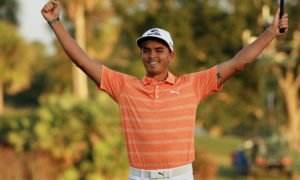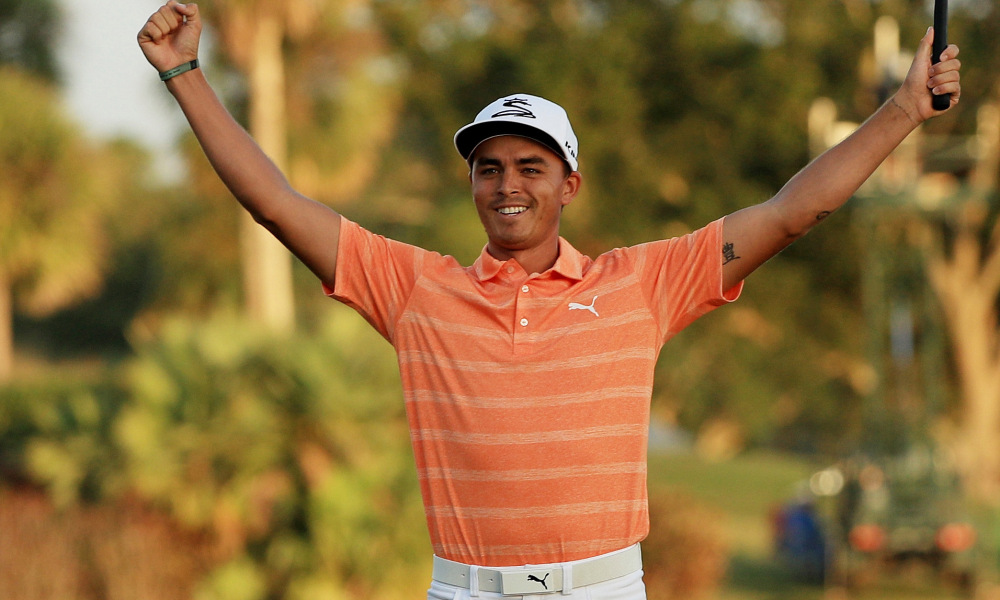2018 Predictions

Now that Christmas has passed and we start looking forward to the new year, I think 2018 will be a good year for golf, and like usual we’ll start it off in Orlando at the 2018 PGA Merchandise Show. The level of participation and overall vibe we get from the show can give one a good idea of how the year will go. There’s always lots of hope and lots of hype, but in my opinion it still comes down to golfers and how often they tee it up with their friends. In the end, the success of this game depends on people, not products. With that in mind, here are my bold predictions for 2018.
Rickie Fowler Will Win a Major
2018 will be Rickie’s year. I predict that he will finally win a major tournament. He finished 2017 by winning Tiger’s tournament – The Hero World Challenge – in The Bahamas against a small but very strong international field. On the PGA Tour he enjoyed career highs in Top Tens (11), Top 25s (17) and Prize Money ($6,083,197). He also had the second lowest scoring average on tour at 69.083 and led the tour in sand saves at 68.66%. he’ll be pushed hard by good buddies Jordan Spieth and Justin Thomas, but I think he’ll use their previous major victories as motivation to join the club.
New Drivers, Prices Pushing $500
It should not come as a shock to anyone that most of the major golf companies will have new drivers for sale in 2018. Naturally, all of them will offer more forgiveness, better control and more distance. The driver is, of course, the most oft changed club in our bag and the promise of a few more yards to gain an advantage on your playing partners is often too attractive to pass up. That’s why the bulk of marketing dollars from companies like Callaway and Taylor Made go into driver sales. While the physics of hitting a golf ball has hit a scientific wall due to limits imposed by the USGA, companies are turning to more advanced materials and adjustability to sell new drivers that can be tuned specifically for each golfer. These changes are also pushing prices higher, and we’ll see the $500 mark become pretty standard for a new driver in 2018. Sadly, it won’t help, but more on that later.
Golf Participation Will Continue To Evolve
According to the National Golf Foundation (NGF), the number of people who played golf on a real golf course in 2016 fell 1.2 percent from 2015 to 23.8 million. Given statistical margin for error, these participation numbers have been more or less flat for the last decade. But the way in which we are measuring golf participation is changing. The NGF is now saying that defining golf participation only as playing 18 holes on a regulation course is too limiting. Thanks to the success of facilities like Topgolf and indoor golf simulators, the NGF was able to add more than 20 million off-course “participants” to the game of golf. 8.2 million of those people never stepped foot on a golf course. Most people that go to Topgolf don’t identify as golfers, but the NGF counts them anyway. If you hit a golf ball with a golf club, to the NGF you are a golfer. However you define it, in 2016 the number of beginning golfers grew 14 percent over 2015 – an all time high. And for the first time in five years, the number of “committed golfers” also grew. If you are reading this, you are probably one of the committed crowd. However you count, it seems the game of golf is seeing increases in participation, and that’s a good thing.
Tiger Woods Will Get Injured Again
Sorry Tiger fans, but you knew this was coming. He looked great at the Hero World Challenge about 3 weeks ago, but it remains to be seen how his surgically repaired back & knees will hold up. We’re talking about a professional golfer who’s had four knee surgeries, four back surgeries and injured his achilles in both legs. Twice. I believe the game of golf is better when Tiger is prowling on Sunday leaderboards, but at this point in his career I just don’t think his body will allow him to compete at the highest level for much longer. Let’s hope he has at least one good major run in him before his body fails him and he’s forced to retire, but expect him to spend some time in 2018 nursing injuries yet again.
I’ll Break 80 as a Righty & Lefty
I’ve played golf seriously since 1990 and I’ve managed to maintain a scratch or better handicap for almost 20 years, so obviously the first part of that prediction is a no-brainer. A plus handicap golfer like me will break 80 at least 90 percent of the time. But the second part will be much more difficult. I used to play left-handed more regularly before I moved to Florida in 1997, but since then I’ve played golf left-handed exactly twice, and it wasn’t pretty. My best round as a lefty was an 83, but that was about 25 years ago. My latest effort with a new lefty set I just scraped together last week was a confidence crushing 96, although I was very rusty and only playing with 11 clubs. I still need to find a driver, 5-wood and 3-hybrid for my lefty set. The goal of breaking 80 left-handed is quite ambitious, but I think I can do it with some practice. I’ll be chronicling this journey right here in the coming months.
New Clubs Still Won’t Help Your Game
That $500 driver you just bought with the fancy adjustable hosel and movable weights? You know, the one that promised more distance and forgiveness? It won’t really help your scores. Sorry to be the bearer of bad news. Even if that new driver really did give you more distance, the improvement likely won’t be noticeable, and your scores won’t improve. Why not? Because you still suck at chipping and putting, that’s why! The golf marketing machine has led you to believe that the driver is the most important club in the bag, but at best you’ll only use it for 14 shots on a regulation golf course. Despite all the advancements in technology the average golfer still shoots around 100. If that sounds like you, driver swings account for less than 15% of your score, and shots with the wedges and putter account for more than 65% of your score. That $500 is much better spent on lessons for your short game than on the shiny new driver.
USGA vs Amateur Golfers
I’m part of the growing number of amateur golfers that love the game and want to see if grow but are becoming frustrated with the direction the USGA is taking the game. When it comes to the rules of golf, we want to see things get simpler and help us play faster. While the USGA and PGA have given us some half-assed initiatives like “Tee it Forward” and “While We’re Young” to help the pace of play for amateurs, they continue to allow players on the professional tours to get away with 5+ hour rounds. When it comes to the rules of golf, we amateurs also keep getting the shaft. A couple of the biggest rule changes we’ve seen recently were squarely aimed at professional golfers, but didn’t really make a difference and instead have negatively impacted the amateur game.
The groove rule change in 2010 was designed to make it harder for professionals to control the ball out of the rough, placing a premium on hitting fairways in an effort to combat the “bomb and gouge” playing style of the Tiger Woods era. It didn’t work of course, as equipment companies countered with higher lofted wedges, more precise CNC machined grooves, shafts designed specifically for wedges that produce more spin, and softer golf balls with more advanced core and cover materials that spin more. The only people that suffered with this rule change were of course amateurs. Not possessing the athletic ability or club head speed to impart spin on the ball like a pro, the wedge game became that much more difficult for the rest of us because of a rule change made with less than 1% of golfers in mind.
The next major rule change banned the use of anchored putters. Everyone knows at least one person who used a “broomstick” or belly putter prior to the ban. Again aimed largely at the professional tours, the USGA and R&A were scared that an anchored putting stroke was an unfair advantage over the un-anchored stroke, even though PGA Tour putting statistics didn’t support that argument. They imagined entire generations of young golfers growing up with belly putters and decided they weren’t having it, so they banned the use of any putting stroke where the club is anchored to your body. How did it work? Well, I know a guy that still uses the putter, just not anchored. He says his putting hasn’t gotten any better or worst since the ban. An other guy I know using a long putter is a tournament level golfer but quit playing USGA sanctioned events in protest. At least those touring professionals can’t take advantage of anchored strokes any more even if it hurts amateurs everywhere. So how did the anchoring ban work out anyway? Well, the two best putters on PGA Tour Champions in 2017 were Berhand Langer and Scott McCarron. What do they have in common? Yeah, you guessed it. They both use a long putter. Nice work USGA.
I’m being pretty hard on the USGA, but it’s not all bad. In fact, the list of proposed rule changes for 2019 are very good, and I think they’ll make the game a little quicker, a little simpler and more enjoyable. It’s a good start for sure. Now, if we can just talk about making divots be treated as ground under repair…


Pingback: 2018 Masters Tournament Preview : intothegrain.com
This post is really great and more beneficial